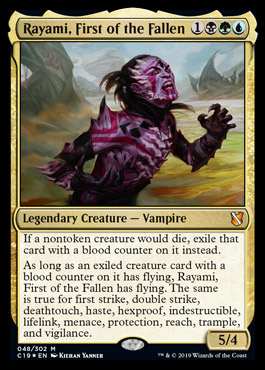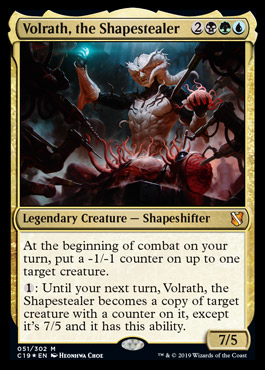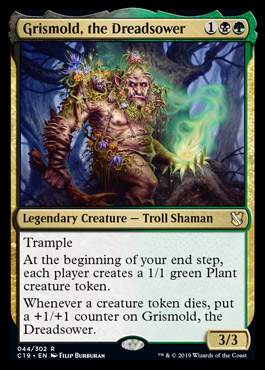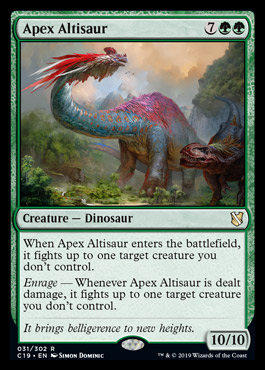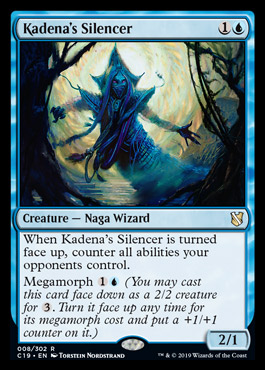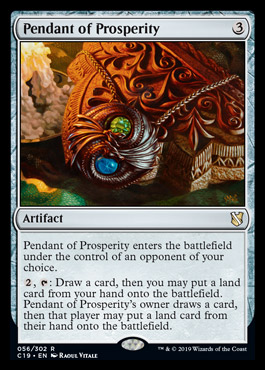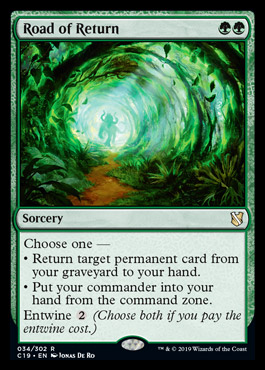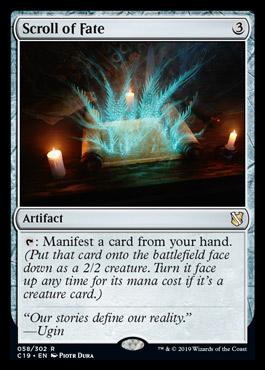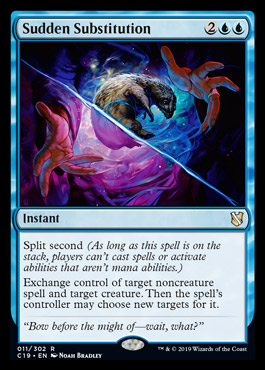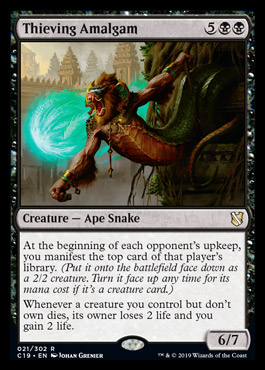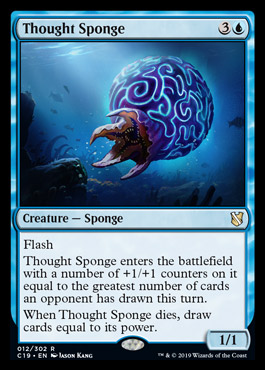(Kadena, Slinking SorcererKadena, Slinking Sorcerer | Art by Caio Monteiro)
EPISODE 1: THE FACELESS MENACE
This may not be Star Wars, and you may not find Jar Jar Binks or Darth Maul in this set review, but with a color combination like Sultai and a theme like Morph, we have plenty of Phantom Menaces to discuss in the Sultai set review of Commander 2019!
Sultai has received many new toys and a few new commanders to play with over the last couple of years, including Muldrotha the GravetideMuldrotha the Gravetide and Yarok, the DesecratedYarok, the Desecrated, both of which have become popular as extremely versatile commanders that can cater to several playstyles. This time around, we've received three new Sultai commanders that all seem to have fairly niche roles and themes while still maintaining some versatility. We have a Morph commander, a Voltron commander, and a counter-based commander, all of which seem to be really interesting and exciting to build! While we have only received two new Morph cards, we also received several new non-commander cards that can fit into a variety of decks. I'm excited to talk about them with you!
Kadena, Slinking Sorcerer
Kadena, Slinking SorcererKadena, Slinking Sorcerer is the face card of the Sultai Morph deck. Barring any effects that increase costs, Kadena reduces the first Morph you cast each turn by three mana, making it free to play. In addition, she provides card advantage by drawing a card every time a face-down creature enters the battlefield under your control, which notably counts for both Morph and Manifest cards. (This is very important for cards like Ghastly ConscriptionGhastly Conscription, since Kadena will draw cards for each of the face-down creatures!) Morph as a theme certainly has a niche following, as there are 465 Morph decks in the EDHREC database, with Animar, Soul of ElementsAnimar, Soul of Elements, Ixidor, Reality SculptorIxidor, Reality Sculptor, and Ezuri, Claw of ProgressEzuri, Claw of Progress as the three main commanders.
While Ezuri gains experience counters from Morphs and Ixidor directly supports face-down creatures, Animar is the closest comparison we can make to how Kadena should be evaluated in the format. After some initial investment, Animar will allow you to play more Morphs for free, allowing you to rapid-fire them into play all at once, while Kadena will discount just one at a time, refilling her hand in a way Animar does not (at least, not without extra support). Don't forget, too, that Kadena says "each turn," meaning that if you have the newly-reprinted Leyline of AnticipationLeyline of Anticipation in play, you can cast a free Morph on your opponents' turns! Kadena decks may even employ self-bounce effects to continually recast Morphs precisely to take advantage of this value train.
Kadena and Animar share two colors, blue and green, but differ on the third, with Animar's third being red and Kadena's being black; this opens up a lot of other doors that Animar can't access. The only significant red Morph-themed cards are Akroma, Angel of FuryAkroma, Angel of Fury, Jeering InstigatorJeering Instigator, Dwarven BlastminerDwarven Blastminer, Fortune ThiefFortune Thief, and Ashcloud PhoenixAshcloud Phoenix. Meanwhile, black adds more options for removal with the likes of Bane of the LivingBane of the Living, Aphetto ExterminatorAphetto Exterminator, Silumgar AssassinSilumgar Assassin, or SkinthinnerSkinthinner. Morph creatures are a lot more difficult for your opponents to play around when they don't know whether you might suddenly flip over a removal spell!
I think Kadena is a welcome commander to the Sultai combination, and as the face card of the faceless deck, will probably see a decent amount of play in the months to come. If you are looking for ways to get started on building this commander, consider using the Animar Morph theme page as a model for some shared Simic cards to begin a brutal brew.
Rayami, First of the Fallen
Similar to Kadena, Rayami, First of the FallenRayami, First of the Fallen is reminiscent of another former commander that shares two of its colors: Mairsil the PretenderMairsil the Pretender. Where Mairsil exiles a card upon his entrance to gain its activated abilities, Rayami waits for creatures to die, and gains their combat abilities, in similar fashion to Cairn WandererCairn Wanderer or SoulflayerSoulflayer.
Rayami is going to do really well with small creatures, using mana dorks like Birds of ParadiseBirds of Paradise and Sylvan CaryatidSylvan Caryatid as cheap ways to put down weak creatures with strong keywords. Once they are on the field, any Viscera SeerViscera Seer or Ashnod’s AltarAshnod’s Altar effect can sacrifice the creature to give Rayami blood counters. Other cards I can see being extremely useful are the Gods from Amonkhet. While strong all on their own, they can also be sacrificed to give Rayami extra keywords, especially indestructible. Of note, if Rayami leaves the battlefield and returns, he will still retain all of the abilities of the exiled cards unless they are removed from exile. Also of note, there are no Sultai cards that have double strike, so you may need to find an enemy's creature to get some of those abilities.
Overall, it seems to me that Rayami may end up filling in some weird hybrid role between a creature-based deck and a Voltron deck, a difficult combination, since Voltron decks rarely cast many other creatures aside from the commander. In this case, creatures are going to be the main source of buffing the commander, which is why cheap creatures will be so effective, along with the use of strong Equipment and spells that boost power toughness. Since Rayami can exile opponents’ creatures as well, board wipes and spot removal will be crucial; it's a crazy world where MurderMurder can now be used as a combat trick to boost your creature! I’m excited to see how people balance these two very different deck styles for this one commander.
Volrath, the Shapestealer
Volrath, the ShapestealerVolrath, the Shapestealer excited me extremely quickly. We’ve received many exciting Sultai commanders recently, several of which are very versatile and have the option for a diversity of themes. Volrath is no different. I have seen many themes suggested already, ranging from +1/+1 counters (similar to Experiment KrajExperiment Kraj) to the -1/-1 counters theme (similar to Hapatra, Vizier of PoisonsHapatra, Vizier of Poisons), and even a CloneClone and Shapeshifter theme, just playing weak creatures with beneficial abilities that become absurd when transferred onto Volrath's 7/5 body. All of these are completely valid and interesting methods to play Volrath, but I think the uniqueness of Volrath really shines when we consider the completely ridiculous variety of counters he can abuse. One of my favorite interactions, though, is the use of level counters from Level Up creatures.
If Volrath becomes, for example, a HexdrinkerHexdrinker, and you add enough level counters to him, not only does he gain the protection abilities, but he can then also become a copy of any other Level Up creature you drop - for example, a Lighthouse ChronologistLighthouse Chronologist - and start using their abilities as well. This also is a prime deck for the use of Tetzimoc, Primal DeathTetzimoc, Primal Death, since one black mana can put a prey counter on any creature that can then become an immediate target for Volrath. Successfully wielding this commander will rely upon your ability to abuse the vast variety of counters that exist across Magic - just make sure you can distinguish between all the different kinds of counters you'll be using!
Grismold, the Dreadsower
Grismold the DreadsowerGrismold the Dreadsower looks like he is from the new plane of Eldraine, a Troll from deep within the murky woods. He seems like some weird combination between Slimefoot, the StowawaySlimefoot, the Stowaway and Mazirek, Kraul Death PriestMazirek, Kraul Death Priest. He clearly wants to end up being a Voltron commander, focused on dealing commander damage to win the game while using tokens as fuel. It is interesting that he makes Plant tokens instead of Saproling tokens, as only seven other creatures make Plants, and Saprolings have much more support. While that sounds like I'm nitpicking, I do think he would see more play if he made Saprolings instead. As is, Grismold requires a lot of slow interactions to eventually become powerful enough to Voltron the rest of the table, so I don't imagine him becoming very popular.
Still, the decks that do use Grismold will have very peculiar synergies. If you can give all tokens negative toughness, such as with Virulent PlagueVirulent Plague, they will die immediately, giving Grismold counters right away. This is also the deck where Primal VigorPrimal Vigor shines brightest, since the symmetrical effect to double your opponents' tokens will actually benefit Grismold when they all die! He may not persuade players away from their Slimefoot, the StowawaySlimefoot, the Stowaway decks, but there's some crazy stuff happening here you won't see elsewhere.
Apex Altisaur
It took me a minute to realize exactly why Apex AltisaurApex Altisaur is so bonkers and good. Its initial ability of fighting a creature is not uncommon for Dinosaurs, and it's great as an enter-the-battlefield ability for spot removal, particularly with a 10/10 body. However, this creature can act as a pseudo board-wipe, because the moment that it fights a creature, its enrage ability is triggered, allowing it to fight another creature. This begins a chain reaction, allowing it to kill as many creatures with 10 or less toughness as you allow it. Because it says “up to one target creature” in the Enrage trigger, you are able to stop this ability whenever you want, so you can save the Altisaur to fight again later, or if need be, you can have it fight to its death to take out problematic creatures. I see this creature doing well in any green deck that likes big creatures (aka most green decks), since the removal ability is pretty impressive. However, the mana cost is extreme. Selvala, Heart of the WildsSelvala, Heart of the Wilds-esque abilities will be necessary to reach this amount of mana. It will also likely see significant play in any Dinosaur tribal deck, as this may be one of the most useful Dinosaurs and one of the most useful Enrage triggers within the tribe.
Gift of Doom
Gift of DoomGift of Doom seems to me like a decent method of going about alternative costs. Deathtouch and indestructible is a frightening combination even on a 1/1 creature, as they can suddenly kill anything and act as a combat deterrent. However, five mana is a significant cost to pay, as is the alternative cost to play it as a three-mana Morph and sacrificing a creature to flip it face-up. Decks that rely upon Morphs often find that once their creatures are face-up, they lose their usefulness, so the sacrifice may indeed be a worthwhile trade-off there. All that said, it's a big investment to grant good defensive abilities to one creature. I don’t see this being played in a variety of decks, but it will shine in Kadena's Morph deck, and perhaps even black-inclusive Enchantress strategies like Daxos, the ReturnedDaxos, the Returned.
Kadena's Silencer
Kadena's SilencerKadena's Silencer strikes me as the type of card I'd like to abuse, especially if you can loop it with IxidronIxidron in some way to repeatedly flip it face-down, but even that has its limits. The Silencer is like a Summary DismissalSummary Dismissal, but it's also not - it doesn't counter spells, just abilities. That can create a neat "gotcha!" moment when you counter a Brago, King EternalBrago, King Eternal trigger or a Lord WindgraceLord Windgrace activation, but I honestly don't see this getting play outside of a dedicated Morph deck.
Pendant of Prosperity
I have historically disliked cards like Pendant of ProsperityPendant of Prosperity. I don’t like giving opponents the choice on a card because they will always choose the best option for them, rather than the best option for you. However, in this case, it also benefits them directly, unlike one-time “choice” cards like ScroungeScrounge or Fact or FictionFact or Fiction. Because of this, the artifact is going to be exactly as good as your opponent makes it. I think that, in certain pods and groupings, you should be able to make an assumption based upon personalities, deck strength, and colors on who the best player to give the pendant would be. Very experienced players may realize that this could potentially accelerate you more than them, and rarely use it, while newer players may be more interested in using the ability every single turn, gaining you tons of advantage. In addition, blue players may be more likely to use this ability with their constant card drawing, so that they may play the extra lands in their hands, while green players probably will be fine with using their own ramp spells rather than helping you out. I think the issue here is not what deck it belongs in, as any deck that struggles with direct ramp but has card draw will enjoy this. Rather, it’s more of whether it will fit within your meta and against your opponents. An automatic staple for Group Hug, this is not, but expect to see this card most frequently in Zedruu, the GreatheartedZedruu, the Greathearted decks.
Road of Return
Road of ReturnRoad of Return seems like great fun for green decks. This only revives permanents, so it's more like a Nature's SpiralNature's Spiral than a RegrowthRegrowth or an Eternal WitnessEternal Witness, and Nature's Spiral only shows up in 726 decks compared to Regrowth's 8,850. Road of ReturnRoad of Return has an extra ability, though, allowing us to put our commander right into our hand, which will avoid any command tax we'd encounter by casting it from the command zone. Instead of paying command tax, we pay the extra mana for this spell, which can also buy us back a card from the graveyard, and if you've had to recast your commander too many times, this can save you a decent chunk of mana. It's a nonspecific card, which means it probably won't show up often, but I can't see a green deck that wouldn't enjoy this.
Scroll of Fate
Scroll of FateScroll of Fate is a great way to trigger Kadena on opponents' turns, but it's also really good with blink effects. By just tapping this artifact, you can sneak a very expensive creature, enchantment, or artifact onto the field, then use Brago, King EternalBrago, King Eternal or Aminatou, the FateshifterAminatou, the Fateshifter to flicker the card, which will bring it back to the battlefield face-up! Whisperwood ElementalWhisperwood Elemental does similar things, but Scroll of Fate can do it more reliably when you want it to, and is harder to get rid of. Whisperwood gives you advantage by just Manifesting the top card of your library, but Scroll allows you to repurpose the cards in your hand, even turning an unnecessary land into an emergency blocker! This card is situational, but the situations where it shines, it shines bright. For a more thorough analysis, check out the recent EDHRECast where they debut this preview card!
Sudden Substitution
Sudden SubstitutionSudden Substitution is a good contender for the "Best C19 flavor text award, but it’s also just an incredible spell. Trading a powerful, expensive noncreature spell like OmniscienceOmniscience, an overloaded Cyclonic RiftCyclonic Rift, a Decree of PainDecree of Pain, or a Sunbird’s InvocationSunbird’s Invocation for a useless Morph that's already been flipped, a creature whose enter-the-battlefield ability has already been used, or simply a creature token is an incredible trade. This has limitless applications and situational uses. In addition, if you don’t have a creature you want to get rid of, you could make the trade between two opponents. For example, trading the Melek, Izzet ParagonMelek, Izzet Paragon player’s Epic ExperimentEpic Experiment for the commander of a creature-heavy deck is an excellent trade that ruins the plans for both opponents by giving them each a card that doesn't help them at all. The easiest comparison to make with this card would be Perplexing ChimeraPerplexing Chimera, which is often flickered to acquire multiple uses, but even with this spell as just a one-shot effect, the uncounterable nature of Split Second and the wacky doors it opens means this card could find a home in several blue decks that want to mess with the game in more ways than just a traditional CounterspellCounterspell.
Thieving Amalgam
Ape Snake is a creature type I did not ever expect to see on a creature, but he sure looks fun! Thieving AmalgamThieving Amalgam is very expensive, but it has a huge 6/7 body and his ability is extremely strong. Manifesting your opponents' cards is a great way to steal creatures, and this ability is especially useful in the Kadena deck, since it will draw a card with Kadena each turn. If you want to take more advantage of the second ability, a deck like Gonti, Lord of LuxuryGonti, Lord of Luxury may find practical uses for this effect, especially since they're already stealing so many cards from their opponents anyways. Seven mana is a lot, though, so you need to find the right deck to make this ability work well.
Thought Sponge
With an ability like flash, this Octopus-looking Thought SpongeThought Sponge puts in so much work, capitalizing on your opponents’ actions. When we evaluate cards like this, we want to analyze how low or high the “floor” and “ceiling” of their abilities will be. The "floor" is the expected outcome if played in a less than ideal situation, while the "ceiling" is how the card will play in a very ideal situation. Since you generally would not play this when an opponent has only drawn one card, the floor is Thought SpongeThought Sponge entering as a 3/3 or 4/4 and drawing 2-3 cards when it dies. This is a relatively high floor, providing a significant amount of value even in less-than-ideal situations.
The potential ceiling for this card, meanwhile, is quite ridiculous. Imagine playing this against a commander like Arjun, the Shifting FlameArjun, the Shifting Flame who has drawn anywhere from 5-30 cards in a single turn. This creature also will be very useful in any deck that uses wheels, like Nekusar the MindrazerNekusar the Mindrazer, which thrives on opponents drawing cards. I also don't mind it in a deck like Pir, Imaginative RascalPir, Imaginative Rascal + Toothy, Imaginary FriendToothy, Imaginary Friend, especially if you can add even more counters to the Sponge before it dies and draw even more cards. The best comparison I can make is to Chasm SkulkerChasm Skulker, which gets bigger over time, while Thought Sponge is one investment that needs to be timed well.
End Credits
What do you think of all the new cards from the Sultai Morph deck? I look forward to seeing what kinds of convoluted decks people come up with for each of these commanders, and to see how they deviate from my expectations and evaluations. Where would you play these new cards? Share in the comments below!
Christian Alexander
While getting a degree in evolutionary biology, Christian spent all of his free time in college building commander decks after being introduced to the MTG in the Theros block. After spending the last several years building and playing biologically-themed tribal decks and surprising people with wonky builds of well-known commanders, he decided to share his thought and design process with the community, incorporating ideas from his many playgroups into articles, while also spending way too much of his life underwater. Find him on twitter @Evol_Leap!
Your opinions are welcome. We love hearing what you think about Magic! We ask that you are always respectful when commenting. Please keep in mind how your comments could be interpreted by others. Personal attacks on our writers or other commenters will not be tolerated. Your comments may be removed if your language could be interpreted as aggressive or disrespectful. You may also be banned from writing further comments.


